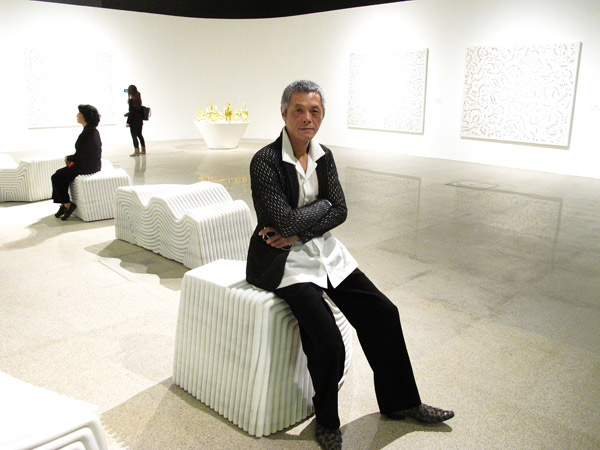
"I'm very excited that my works are being displayed in a space of immense energy and historical significance. It is the same palace where the archaic bronze wares, jade articles made before the Han Dynasty (206 BC-AD 220) and porcelains are housed," he says.
Chen Lyusheng, the museum's deputy director and the exhibition's curator, says the sophistication of works on display fully reveals Huang's scholarly charisma, and his special hobby for symbols motivates him to invent and extend the meaning of all kinds of symbols in his works.
"He keeps forcing these symbols on the viewers, and he presents these symbols in different ways to continuously thrill people," Chen says.
He says Huang has developed a dialectic method of his own by enhancing the tension and contradictions in his works, just like the contrast formed by the black-and-white walls of the hall where the exhibition is held.
"Possessing a Thousand Peaks shows his exploration with such unique materials as the white marbles he found in Beijing. It doesn't matter at all whether they are sculptures or installations. Huang designs these carved-out wave patterns on the stones with great attention to detail. Visitors can have a unique experience interacting with them - they can just sit on them," Chen says.
Huang doesn't revisit the same theme in his paintings, which, Chen says, is why he appreciates his work - he never repeats the symbols like a machine of mass-production.
"Huang has assembled a vocabulary of his art to express what he wants to say. This is an important dimension of a great artist," says Britta Erickson, artistic director of the Beijing-based Ink Studio, which displays Huang's works and has co-organized the exhibition.
"He ponders issues that are relevant to everyone. His sizable ink paintings address the relationship between man and nature: people, plants and animals all originate from the same chaos; the environmental issues are basically human problems," she says.
A close observer of Huang's creative process, Chen says the artist is more like a literati of old times, who invests a lot of time thinking and constructing the basic methods of his art.
"His thoughts of Chinese philosophy, based on his life experiences in Taiwan and the mainland, distinguish Huang from other Chinese artists of his time."
If you go
9 am-5 pm, daily except Monday until April 18. National Museum of China, east side of Tian'anmen Square, 16 East Chang'an Avenue, Dongcheng district, Beijing. 010-6511-6400.
We Recommend:
